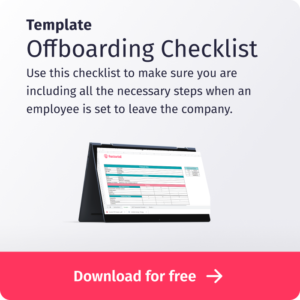For HR managers in Illinois, knowing about the state’s WARN Act is crucial for handling big changes in the workforce, like mass layoffs or shutting down plants. This guide gives you all the important details about the specific rules in Illinois, including what you need to do, when it applies, what it covers, and when it doesn’t. Following these rules makes sure that changes in the workforce are fair and clear, following both federal and state laws to create a good workplace atmosphere. Keep reading to understand how the Worker Adjustment and Retraining Notification Act works differently at the federal level compared to Illinois.
TABLE OF CONTENTS
- What is the WARN Act in Illinois?
- Illinois WARN Act Requirements
- Illinois WARN Act Triggers
- WARN Act Illinois Definitions
- Illinois WARN Act Exceptions
- Illinois State WARN Notice
- Illinois Layoff Offboarding
- Offboarding software 🚀
What is the WARN Act in Illinois?
The Illinois Worker Adjustment and Retraining Notification (WARN) Act is a crucial state-level legislation designed to protect employees in the face of impending layoffs or plant closures. Understanding this law is essential for HR managers to ensure compliance and foster a fair work environment.
Every US state is bound by federal WARN Act regulations. However, certain states, including Illinois, California, New York, New Jersey, and Wisconsin have additional, more stringent regulations that apply to businesses and employees within their borders.
Illinois, in particular, has distinct state WARN laws governing layoffs. If your organization is conducting layoffs in Illinois, it’s crucial to be aware of and adhere to these state-specific regulations.
Thankfully, the Illinois WARN Act aligns closely with the federal WARN Act, minimizing variations. We will take a look at these key differences as well.
Related: Illinois State Holiday Calendar
Illinois WARN Act Requirements
In Illinois, the WARN Act applies to employers who have 75 or more full-time workers and to give 60 days notice, which is different from the federal WARN Act. This difference is really important for HR managers to be aware of because it affects when the law is triggered, what kind of notice needs to be given, and how it’s enforced. It is crucial for Illinois employers to understand the difference between Illinois WARN Act vs. Federal WARN Act triggers to remain compliant.
Illinois WARN Act Triggers
In Illinois, the Worker Adjustment and Retraining Notification (WARN) Act lays out certain situations that activate its rules. These situations are primarily related to big layoffs or shutting down plants, which means employers have to follow specific notice requirements that dictate how and when they need to give employees notice about these changes. It’s really important for employers and HR managers to understand these triggers so they can handle changes in the workforce properly and follow the state’s rules.
WARN Act Illinois Trigger Definitions
In Illinois, the Worker Adjustment and Retraining Notification (WARN) Act is triggered under the following circumstances:
1. Mass Layoff:
- 25 or more full-time employees are laid off, and they constitute one-third or more of the full-time employees at the site, or
- 250 or more full-time employees are laid off at a single site.
2. Plant Closure:
- Closure of a site that employs 50 or more employees.
These triggering events require employers to provide advance notice to affected employees, the Local Workforce Development Board, and relevant local government officials to ensure transparency and preparedness during significant workforce changes.
Related: Illinois FMLA Guide
Illinois WARN Act Exceptions
In Illinois, the WARN Act typically covers organizations with more than 100 full-time employees, including both public and private companies, as well as for-profit and non-profit organizations. If there’s a plant closing or a big layoff, employers have to give a WARN notice to make sure employees know what’s happening and can get ready for the changes.
The Illinois WARN Act is all about making sure employees are protected during big shifts in the workforce. It does have some exceptions for special situations, though. Employers need to know about these exceptions so they can handle the Act the right way.
Key exceptions include:
1. Project Completion or Undertaking:
– No notice required if the closing or layoff results from completing a specific project or undertaking. Applies to certain industries and when employees were hired for a limited duration.
2. Seasonal Employment:
– No notice required for employees in seasonal and temporary positions.
3. Physical Calamity or Act of War:
– No notice required in cases of mass layoffs, relocations, or plant closures due to a physical calamity or act of war.
4. Capital or Business Pursuit: No notice required if, under specific conditions, the employer actively sought capital or business, and a WARN notice would hinder the process. (Only applies to plant closing)
Understanding and applying these exceptions is crucial for employers to ensure compliance with the Illinois WARN Act during unique circumstances and exceptions.
Illinois State WARN Notice enforcement
Enforcement of the Illinois WARN Act differs from the federal counterpart. While the federal government and state cannot initiate actions for non-compliance, the Illinois law empowers the Director of the Illinois Department of Labor to make rules and conduct investigations. The Director has the authority to examine the books and records of an employer during any investigation or proceeding to determine compliance.
In conclusion, HR managers must navigate the nuances of the Illinois WARN Act to ensure compliance with state regulations, understand the specific triggers, and execute proper notice procedures. By doing so, organizations can uphold employee rights and maintain a positive workplace environment during times of significant workforce changes.
Related: Illinois Minimum Wage Explained
Illinois Layoff Offboarding
Understanding and complying with the WARN Act is crucial for HR managers, fostering fairness and transparency during workforce changes. By ensuring employee rights and maintaining open communication, HR professionals contribute to a positive workplace culture and compliance with regulations. After notifying employees of impending layoffs, the next crucial step is initiating the employee offboarding process.
Offboarding with Factorial:
Factorial simplifies the offboarding process, streamlining tasks and ensuring a smooth transition for departing employees. With Factorial, you can efficiently manage exit procedures, such as collecting company assets, updating access permissions, and conducting exit interviews. Offboarding software simplifies the entire process from start to finish.
Key Features for offboarding during layoffs:
1. Clear Communication: Easily communicate departure details to the departing employee, including the last day of work, return of company property, and other essential information.
2. Task Automation: Automate offboarding tasks, such as revoking system access, updating records, and notifying relevant departments, saving time and minimizing the risk of oversight.
3. Documentation and Compliance: Ensure compliance by generating necessary documentation, such as termination letters and exit surveys, helping you maintain a comprehensive record of the offboarding process.
4. Access Control: Centralize access control management, making it simple to revoke access to company systems and confidential information, safeguarding your organization’s data.
By utilizing Factorial for offboarding, HR managers can enhance efficiency, maintain compliance, and provide a positive experience for departing employees.





